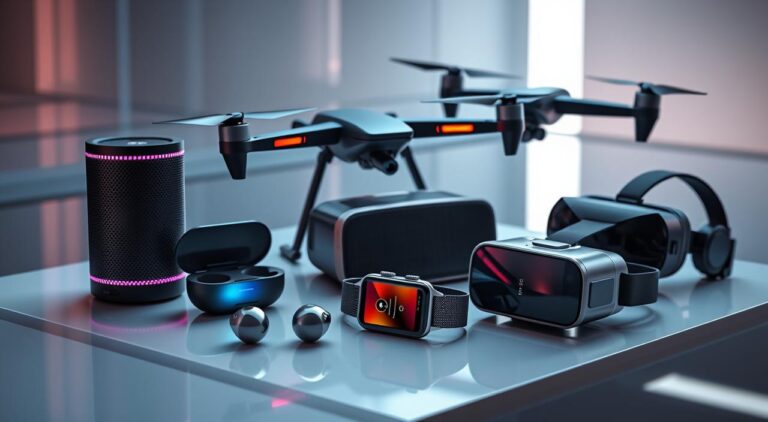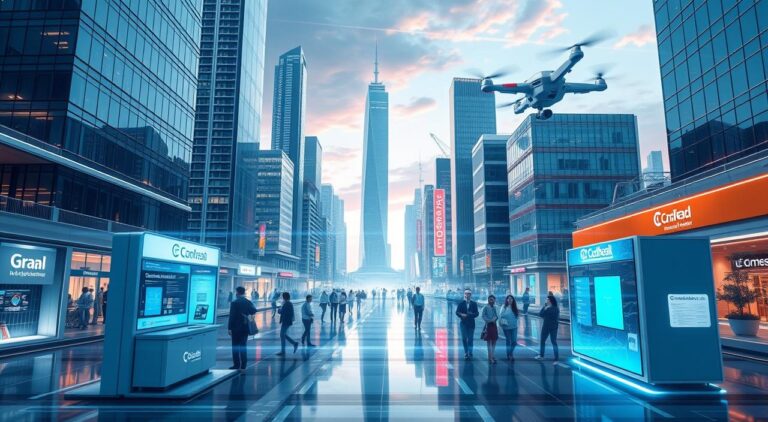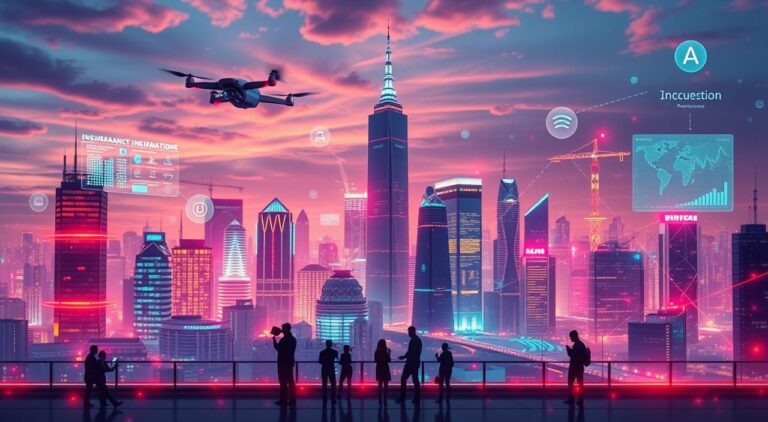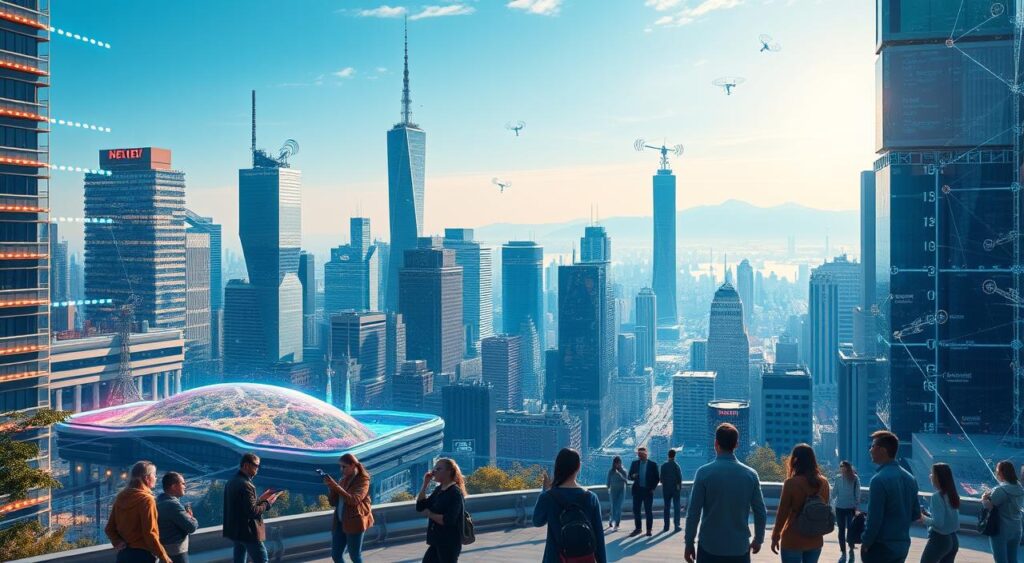
Imagine a world where virtual reality (VR) is so real, it amazes you. A world where the digital and physical mix, letting us explore and play in new ways. This dream is becoming real, thanks to 5G technology.
So, what makes 5G special for VR? How will it change the VR world? We’ll dive into these questions, looking at how 5G will change immersive experiences.
Key Takeaways
- 5G’s ultra-low latency and high-speed data transfer will make VR interactions smooth and real-time.
- Cloud rendering and edge computing with 5G will improve mobile VR performance.
- 5G will make multiplayer and social VR better, thanks to its low latency and high bandwidth.
- 5G will solve VR’s current problems, like hardware limits and network issues.
- The mix of 5G and VR will change many industries, making remote work and training better.
Understanding the Evolution of 5G Network Technology
The journey of cellular network technology has been amazing. It started with 1G, which allowed basic voice calls. Now, we have 5G, which offers fast speeds and high bandwidth. This evolution has changed how we connect and communicate.
From 1G to 5G: A Technical Journey
The move from 1G to 5G has seen big improvements. Each step, from 2G to 4G, added more features. 5G is a huge leap, offering 5g network speeds that are unmatched. It’s opening up a new world of connectivity.
Key Components of 5G Infrastructure
5G’s success relies on several key parts. These include advanced antennas, mmWave technology, and edge computing. These innovations bring high bandwidth and fast speeds. They’re changing how we use digital devices and services.
Current 5G Implementation Status
5G networks are being rolled out fast, with big players in the US leading the way. Coverage is growing, and edge computing is being added. This will unlock 5G’s full power, changing our digital lives.
How 5G Will Impact Virtual Reality Applications
The arrival of 5G technology is about to change virtual reality (VR) forever. We’ll see how 5G will make VR better, with smoother and more realistic experiences. It will also make cloud rendering easier and faster.
5G will make VR graphics look amazing. It will bring fast data speeds and low latency. This means VR will show us stunning, real-like visuals, making our experiences more immersive than ever.
5G will also make VR interactions smoother. You’ll feel more natural and less likely to get motion sickness. This makes VR more enjoyable and opens up new possibilities for virtual worlds.
5G’s fast data transfer will also change cloud rendering for VR. It will let VR devices handle more complex graphics without needing big, heavy hardware. This makes VR more affordable and accessible, helping it grow and evolve.
Exploring 5G and VR shows us a future full of amazing experiences. It will captivate users and expand what’s possible in the virtual world.
Breaking Down 5G’s Ultra-Low Latency Benefits
5G is changing the game with its ultra-low latency. This tech is set to make virtual reality (VR) even better. It promises immersive experiences and real-time rendering.
Real-World Response Time Improvements
5G’s ultra-low latency means response times as fast as 1 millisecond. This will change how we use VR apps. No more lag, just smooth, natural interactions.
Imagine VR that feels almost real. That’s what 5G’s ultra-low latency makes possible.
Impact on Motion Sickness Reduction
VR has always had a problem with motion sickness. But 5G’s ultra-low latency is here to help. It makes VR environments render faster, reducing disorientation and nausea.
This means longer, more enjoyable VR sessions. And it opens up new possibilities for immersive experiences.
Enhanced User Experience Metrics
- Reduced latency for seamless, intuitive interactions
- Decreased motion sickness for longer, more comfortable VR sessions
- Improved user satisfaction and engagement with VR applications
5G’s ultra-low latency is ushering in a new era of VR. Users will soon be able to dive into virtual worlds without technical limits. This leap forward will make VR a big part of our lives.
High-Speed Data Transfer and Bandwidth Capabilities
Exploring 5G technology reveals its amazing features for fast data transfer and bandwidth. These abilities will change the virtual reality (VR) world. They will make virtual environments more detailed and streaming of VR content smoother.
5G stands out for its high bandwidth and high-speed data transfer. It can reach download speeds of up to 10 Gbps and has very low latency. This means VR experiences will be fast and without lag, offering high-quality virtual worlds.
| Metric | 4G LTE | 5G |
|---|---|---|
| Download Speed | 100 Mbps | 10 Gbps |
| Latency | 50 ms | 1 ms |
| Bandwidth | Moderate | High |
5G also makes cloud rendering possible. This technology moves complex graphics processing to remote servers. This lets devices focus on delivering a smooth and immersive VR experience.
The combination of high-speed data transfer, high bandwidth, and cloud rendering will start a new era in VR. Users will see better visuals, faster responses, and deeper immersion.
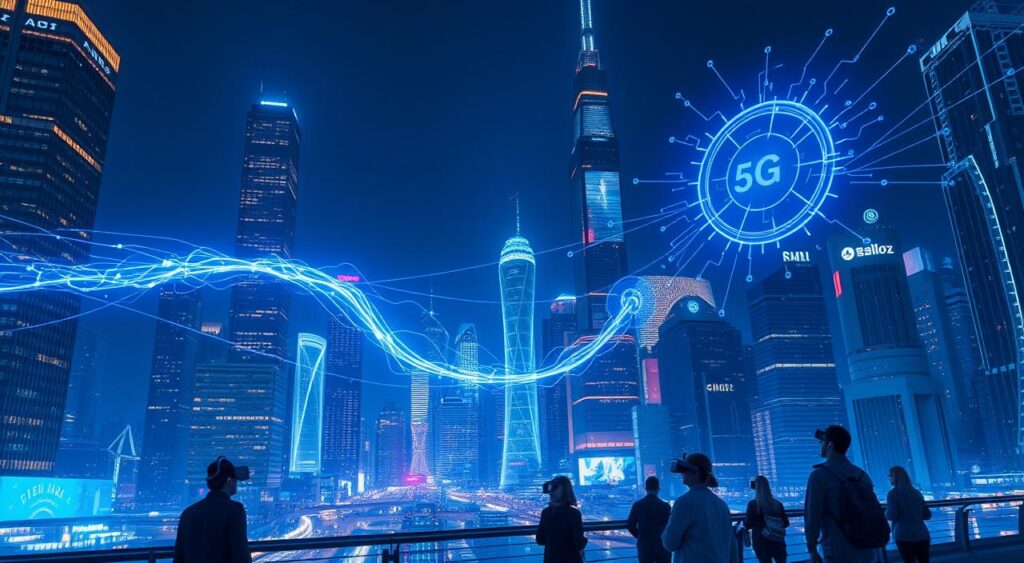
Cloud Rendering and Edge Computing Integration
The arrival of 5G has changed how we use virtual reality (VR). It makes it easy to mix cloud rendering and edge computing. This combo lets us create better VR experiences without the old limits of processing on devices.
Distributed Computing Architecture
5G’s fast speeds and low latency make it great for VR. It lets us move hard VR tasks to the cloud. This means we can have better graphics and smoother actions without needing big, expensive headsets.
Using the cloud’s power, VR can show us better visuals and work faster. This makes our VR time more enjoyable.
Processing Power Optimization
Edge computing adds to the cloud’s power by making it closer to us. This cuts down on delays and makes things more responsive. VR apps can then use their power better, making our experience smoother and less likely to cause sickness.
Resource Management Solutions
Managing resources well is key for cloud and edge computing in VR. Smart algorithms and load balancing make sure we get the best VR experience. This also saves money and energy in VR setups.
Thanks to 5G, cloud rendering and edge computing have opened up new VR possibilities. With distributed computing and smart resource use, VR can now offer amazing visuals, fast action, and a deep dive into virtual worlds. It’s a big step past the old ways of doing things.
Revolutionizing Mobile VR Experiences
The 5G network is changing how we experience mobile virtual reality (VR). It brings fast data speeds and high bandwidth. This means we can enjoy top-notch VR content anywhere.
One big plus of 5G is its speed. It lets VR devices stream and handle complex scenes easily. This is a big step up from older networks.
5G also cuts down on delays. This makes VR feel more natural and smooth. It helps prevent sickness and disorientation.
Cloud rendering and edge computing work with 5G. They let VR devices handle tough tasks remotely. This means we can have more detailed and advanced VR experiences, even on basic phones.
This change will make mobile VR much more popular. We’ll see better, more immersive experiences on the go. It opens up new uses, like better gaming, entertainment, and even work and training.
| Feature | Benefit |
|---|---|
| High Bandwidth | Supports streaming of complex virtual environments |
| Low Latency | Enhances natural interactions and reduces motion sickness |
| Cloud Rendering and Edge Computing | Enables more visually stunning VR experiences on mobile devices |
The 5G network is set to change mobile VR for the better. We’re looking at a future with deeper immersion, easier access, and endless possibilities. It’s a new chapter in virtual exploration and teamwork.
Enhanced Multiplayer and Social VR Interactions
The 5G revolution is changing virtual reality, especially in multiplayer and social interactions. 5G’s ultra-low latency and fast data transfer are making immersive experiences better. Users can now interact in real-time, creating a seamless virtual world.
Real-time Avatar Rendering
5G makes it possible to render avatars in real-time. This means users can see each other’s movements and expressions accurately. It makes virtual interactions feel more natural and engaging.
Synchronized Virtual Environments
5G’s low latency allows virtual environments to sync across users perfectly. This ensures everyone has the same experience. It’s great for teamwork, shared adventures, and deeper immersion.
Social Features Innovation
Real-time rendering and synchronized environments open up new social features in VR. Users can now have virtual gatherings, group activities, and solve problems together. The possibilities for social VR are endless, offering new ways to connect and engage.
| Feature | Description | Impact |
|---|---|---|
| Real-time Avatar Rendering | Avatars that accurately reflect user movements and expressions in real-time | Enhanced sense of presence and more natural social interactions |
| Synchronized Virtual Environments | Seamless synchronization of the virtual world across multiple users | Enables collaborative activities, shared experiences, and heightened immersion |
| Social Features Innovation | New and innovative ways for users to interact, collaborate, and engage in VR | Unprecedented levels of engagement, connectivity, and social experiences |
5G’s power is transforming virtual reality, making it better for multiplayer and social interactions. The future of VR is exciting, and 5G will drive this change.
Industrial Applications and Remote Collaboration
5G technology has changed the game for industrial uses and remote work. It offers ultra-low latency and fast data transfer. This makes virtual reality (VR) in the industrial world much better.
5G is especially good for remote work and training. Imagine doing live, interactive training with people all over the world. 5G makes it possible to have virtual sessions that feel real, thanks to remote collaboration.
Also, 5G works well with edge computing and real-time rendering. This means complex 3D models and simulations can be processed quickly. Users get a smooth and realistic experience.
“5G is the backbone that enables remote collaboration and training simulations in the industrial sector, transforming the way we approach workforce development and productivity.”
5G opens up many new possibilities. It’s great for remote maintenance, repair, and even virtual factory tours. It lets industrial workers collaborate, train, and solve problems in new ways. This leads to better efficiency, cost savings, and safety in many industries.
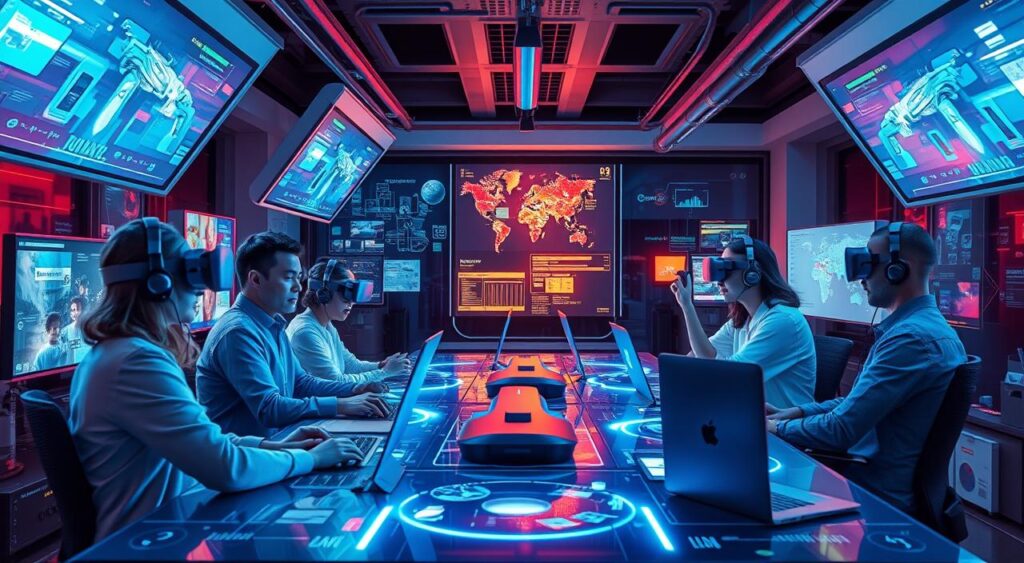
Overcoming Current VR Technology Limitations
The 5G network is changing the virtual reality (VR) world. It helps us face the current VR hardware and software limits. With 5G’s fast data transfer and cloud rendering, we can now offer a better VR experience.
Hardware Constraints Solutions
VR has faced a big challenge: keeping up with processing needs. 5G’s low latency and high bandwidth make cloud-based rendering possible. This lets VR headsets use powerful edge servers for tasks, making them lighter, more comfortable, and cheaper.
Network Performance Optimization
For a great VR experience, network reliability is key. 5G’s ultra-low latency and fast data transfer ensure smooth data flow. This reduces lag and jitter, making VR more natural and responsive.
Content Delivery Improvements
VR content’s complexity and size have been big hurdles. But, 5G’s high bandwidth and cloud rendering make content delivery fast and efficient. This means we can create and share more detailed, stunning VR experiences.
By tackling hardware, network, and content delivery issues, 5G is set to unlock VR’s full potential. It’s bringing us into a new era of virtual experiences.
Future Prospects and Market Growth
The 5G network is set to change the virtual reality (VR) world. It will open up new ways for us to experience things. As 5G gets better and more people use it, we’ll see more advanced VR in many areas.
One big area is entertainment. Virtual reality applications powered by 5G will change how we play games. We’ll see games that feel real and fast, with players connecting in new ways.
But 5G’s impact won’t stop at fun. It will also change education, healthcare, and how we work together. Imagine virtual classrooms with holographic teachers or remote surgeries with doctors worldwide working together.
Experts say the 5G network market will grow a lot. It’s expected to hit over $700 billion by 2025. This growth will help make new VR tech, changing how we live and learn.
| Metric | Projection |
|---|---|
| Global 5G Market Size | $719.8 billion by 2025 |
| Annual Growth Rate | 47.2% (2019-2025) |
| 5G Connections Worldwide | 1.01 billion by 2023 |
As 5G network keeps getting better, our VR experiences will change a lot. The future is full of possibilities for immersive experiences that will amaze and inspire us.
Conclusion
5G technology is changing virtual reality in big ways. It brings ultra-low latency, fast data transfer, and cloud rendering. These features can make VR experiences much better.
5G can solve problems like slow networks and old hardware. This means we’ll see more realistic and interactive VR. It’s going to change how we use virtual reality.
The future of VR depends on 5G. With 5G, VR will become more mobile and easy to use. We won’t need big, heavy devices anymore.
5G and VR together open up new possibilities. We’ll see better use in work and fun activities. It’s a chance for more social and fun VR experiences.
As 5G grows, VR will change slowly but surely. It will become more immersive and easy to use. This will make the real and digital worlds closer together.
The future of VR with 5G is exciting. We can’t wait to see what new things it will bring. It’s going to be a big change for VR.
